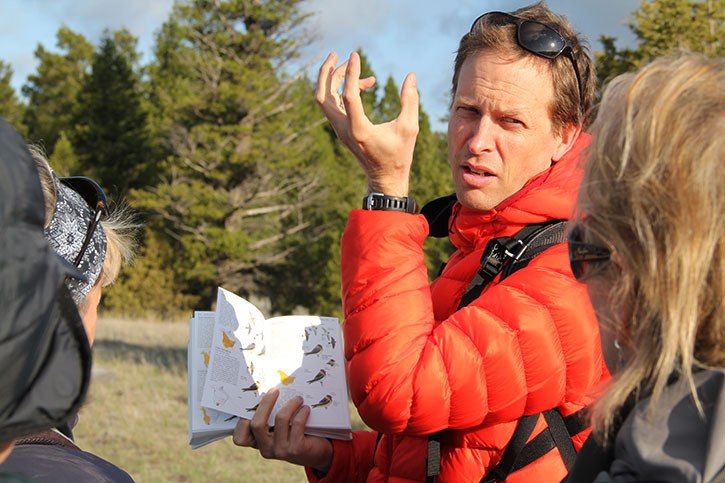 I’ve never been a birdwatcher.
I’ve never been a birdwatcher.
I mean, I watch birds all the time. But the thought of actively looking for them, binoculars and bird book in hand, never particularly appealed to me. Maybe because it always seemed a little, well, slow. I’m drawn to action sports — scrambling, biking, skiing, snowboarding… but when Wildsight Invermere president Baiba Morrow extended an invitation to join a birding excursion led by Cam Gillies, co-owner of Eagle Eye Tours, I couldn’t say no. Cam is highly respected for what he does and Earth Day was coming up, so I felt it was the right thing to do. A little reluctantly, I agreed to give up my lazy Saturday morning sleep in and meet a group of eager birdwatchers at Ritchies Point parking lot along Westside Road just north of Wilmer this past Saturday morning.
With sleep still in my eyes, I rolled up in my car at 8:31 a.m. feeling a little out of sorts because I hadn’t left enough time to grab my morning coffee, only to realize I was the last person to arrive.
But the energy level of the group — there were about 15 of us — was high and you couldn’t have asked for a more spectacular day. The sun was bright, the deep blue of the sky was beautifully reflected in the wetlands, and the peace and calm of the scenery was interrupted only by the excited chatter of our group, the faint sound of the breeze brushing through the trees and dried grass, and the occasional bird call, or song.
A call was different from a song, I quickly learned, and experienced birders know how to distinguish between the two. Only males sing, said Cam, either to defend their territory or attract females. It turns out the male’s song (I think he was talking about thrushes) was a familiar sound…. CHEESE (high sound) bur-ger (low sound), whereas the call … chickadeedeedee… is more of an intergroup communication done year round by both males and females.
Another interesting fact — the CHEESE bur-ger song is only heard in the spring, right around now.
Cam was full of facts and figures that he was quick to share. For instance, there is a very small bird called a Blackpoll Warbler that weighs just 12 grams. Data scientists put tiny geo locaters on the backs of these birds that keep track of the sunset, sunrise and length of day so they could tell where the bird was on the planet (GPS are too heavy). What they discovered is that these warblers go to the Eastern seaboard (Newfoundland, Nova Scotia) in fall migration, double their weight, then fly straight to Venezuela in 72 hours. Amazing.
“Everybody suspected this is what these warblers were doing,” explained Cam, “but nobody had cold, hard evidence that they could do it in three days, non-stop.”
The tour continued with the more experienced birdwatchers in the group occasionally pointing in a general direction while exclaiming excitedly. Cam would swivel his Swarovski spotting scope and zoom in on the target, then step away and allow the rest of us a close up g limpse of whatever fascinating bird it was, from swans to Mergansers to American pipits.
limpse of whatever fascinating bird it was, from swans to Mergansers to American pipits.
I’d never even heard of a pipit. These gorgeous little colourful creatures breed in the Alpine and the Arctic tundra, and manage to thrive in pretty harsh conditions. One was walking through the grass on a ridge about 50 feet away, and with the help of Cam’s Swarovski scope, I could see it picking insects or seeds out of the ground.
A popular international destination, the Columbia Wetlands attract species of birds from all the countries in South and Central America.
“We probably don’t get any migrants from Chile,” said Cam. “It’s really different habitat.”
Three kestrels flew into view (a type of falcon that eats small mammals) and proceeded to battle it out in the sky, then a Western Meadowlark perched on top of a nearby tree and began to sing his heart out.
“Because he’s singing here, he plans to breed,” explained Cam.
I’d walked out to this point many times before and had relished in the gorgeous river and mountain views, but this time was different.
As I listened to Cam’s educational banter and continued to take my turn peering through the scope, I began to feel as though a layer was being pulled away from the familiar scene before me, revealing a startlingly different landscape than the one I was used to, one with so much more context and depth — and life.
Now I’m in the market for a set of binoculars, and maybe, just maybe, I’ll invest in a bird guide. Then again, there’s this great app I was told about…
Nicole Trigg is the editor of The Valley Echo and a newly anointed birder.
